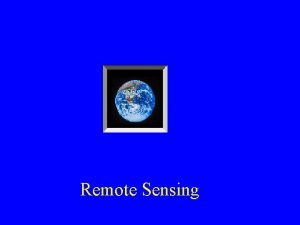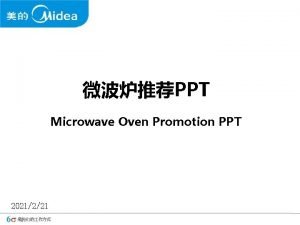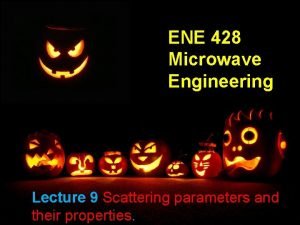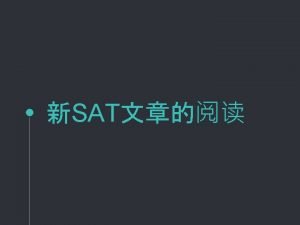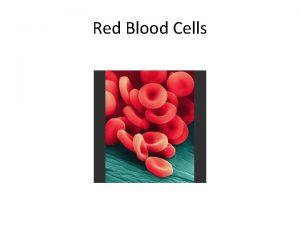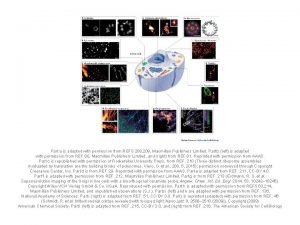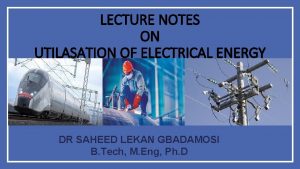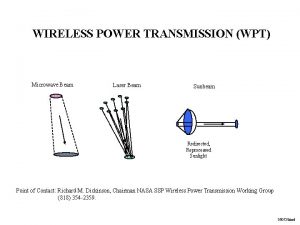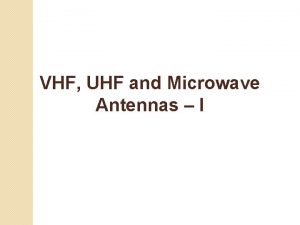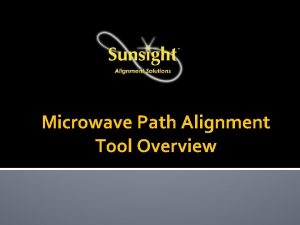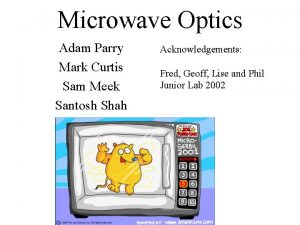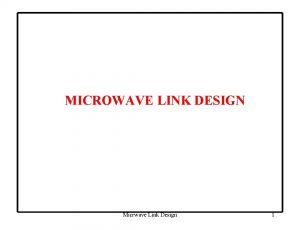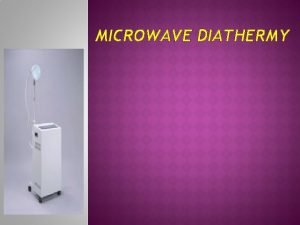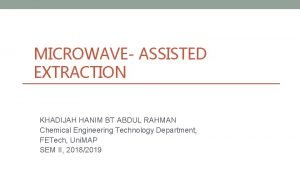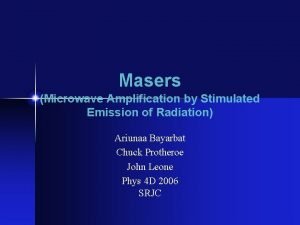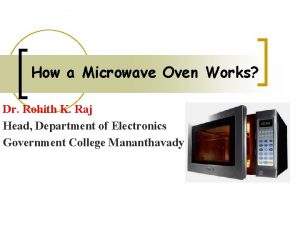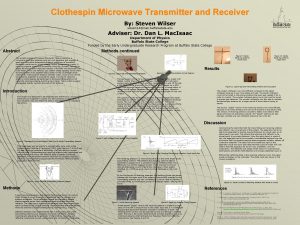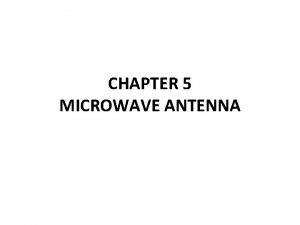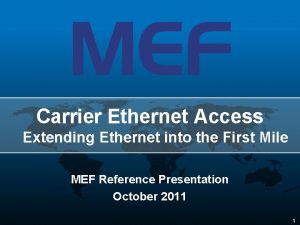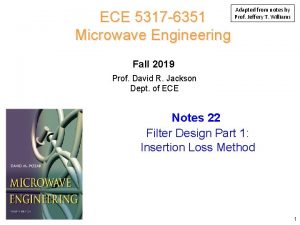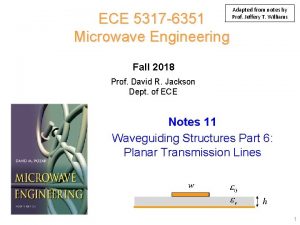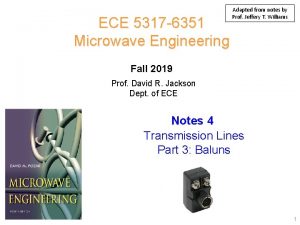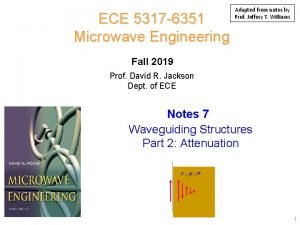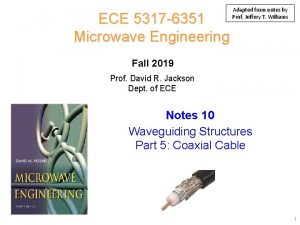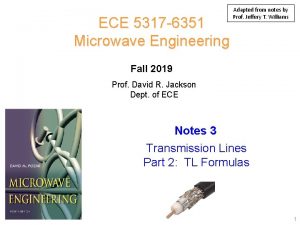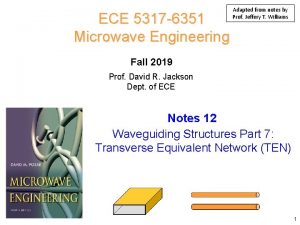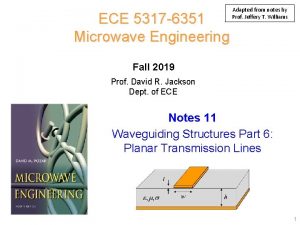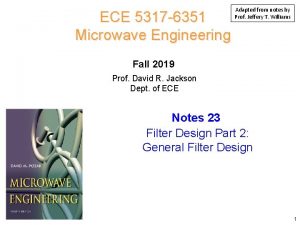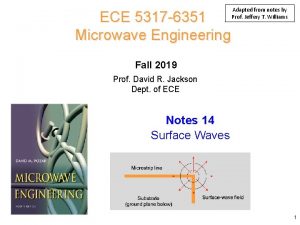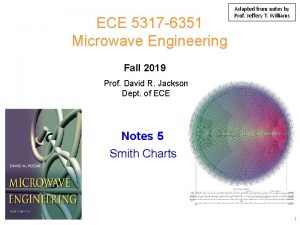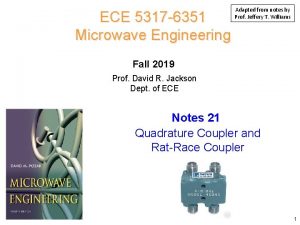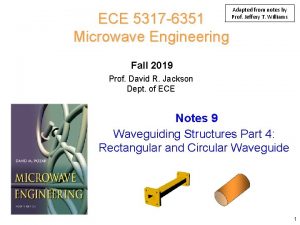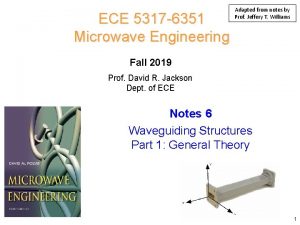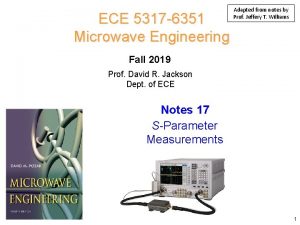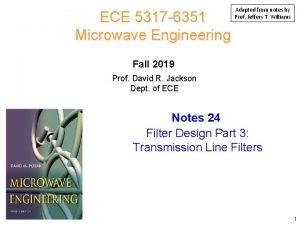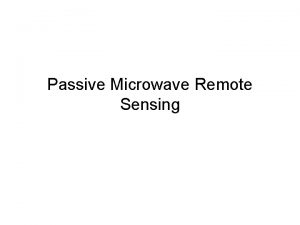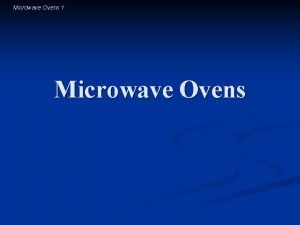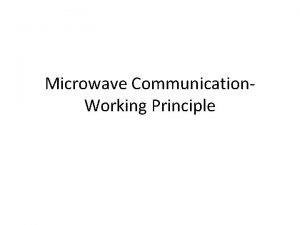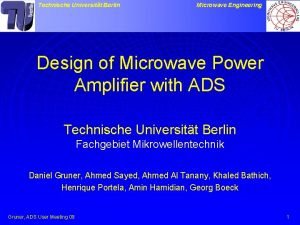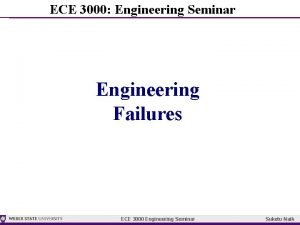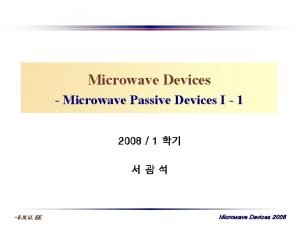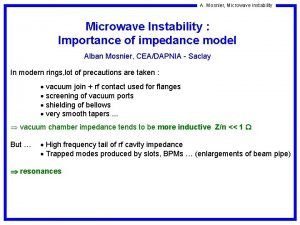ECE 5317 6351 Microwave Engineering Adapted from notes












































- Slides: 44

ECE 5317 -6351 Microwave Engineering Adapted from notes by Prof. Jeffery T. Williams Fall 2019 Prof. David R. Jackson Dept. of ECE Notes 20 Power Dividers and Circulators 1

Power Dividers and Couplers v A power divider is used to split a signal. v A coupler is used to combine a signal. These are examples of a three-port network. 2

Three Port Networks General 3 -port network: 3

Three Port Networks (cont. ) If all three ports are matched, and the device is reciprocal and lossless, we have: (The S matrix is unitary. ) (There are three distinct values. ) Such a device is not physically possible! (Please see the next slide. ) Conclusion: If we want a match at all ports, we have to have a lossy device. 4

Power Dividers and Couplers (cont. ) Lossless, reciprocal, and matched at all ports is not physically possible. Lossless [S] is unitary Hence: These cannot all be satisfied. Only one of them can be nonzero. At least 2 of S 13, S 12, S 23 must be zero. (If only one is zero (or none is zero), we cannot satisfy all three. ) 5

Power Dividers T-Junction: A lossless divider If we match at port 1, we cannot match at the other ports! Note: Matching at ports 2 and 3 would be helpful when output lines 2 and 3 are not matched to their loads. 6

Power Dividers (cont. ) Assuming port 1 matched: We can design the splitter to control the powers going into the two output lines. 7

Power Dividers (cont. ) Examine the reflection at each port (Sii): Note: A match on port 1 requires: (The two output lines combine in parallel. ) The first term in the numerators must be less than the second term. 8

Power Dividers (cont. ) Also, we have: Also Similarly: Hence 9

Power Dividers (cont. ) If port 1 is matched: From last slide: The output ports 2 and 3 are not isolated. 10

Power Dividers (cont. ) Summary § The input port is matched, but not the output ports. § The output ports are not isolated. Waves reflected from devices on ports 2 and 3 with cause interference with the other devices. 11

Power Dividers (cont. ) Example: Microstrip T-junction power divider Incident Note: Quarter-wave transformers could be put on the output lines to bring the final output lines back to 50 [ ]. 12

Power Dividers (cont. ) The matched power divider also works as a matched power combiner. outgoing Equal waves are incident from ports 2 and 3 (a 2 = a 3). There is no reflection if equal waves are incident on ports 2 and 3, and port 1 is matched. 13

Wilkinson Power Divider Equal-split (3 d. B) power divider (The Wilkenson can also be designed to have an unequal split. ) § All ports matched (S 11 = S 22 = S 33 = 0) § Output ports are isolated (S 23 = S 32 = 0) Note: No power is lost in going from port 1 to ports 2 and 3: Obviously not unitary The derivation is in the appendix. 14

Wilkinson Power Divider (cont. ) Microstrip layout All three ports are matched, and the output ports are isolated. 15

Wilkinson Power Divider (cont. ) § When a wave is incident from port 1, half of the total incident power gets transmitted to each output port (no loss of power). § When a wave is incident from port 2 or port 3, half of the power gets transmitted to port 1 and half gets absorbed by the resistor, but nothing gets through to the other output port (the two output ports are isolated from each other). 16

Wilkinson Power Divider (cont. ) Example: Microstrip Wilkinson power divider 17

Wilkinson Power Divider (cont. ) Figure 7. 15 of Pozar Photograph of a four-way corporate power divider network using three microstrip Wilkinson power dividers. Note the isolation chip resistors. Courtesy of M. D. Abouzahra, MIT Lincoln Laboratory. 18

Wilkinson Power Divider (cont. ) Figure 7. 12 of Pozar Frequency response of an equal-split Wilkinson power divider. Port 1 is the input port; ports 2 and 3 are the output ports. 19

Circulators Now consider a 3 -port network that is non-reciprocal, with all ports matched, and is lossless: “Circulator” (There are six distinct values. ) Lossless These equations will be satisfied if: 1 (unitary) 2 or 20

Circulators (cont. ) Clockwise (LH) circulator 1 Note: We have assumed here that the phases of all the S parameters are zero. 2 A wave goes in one port and comes out from the adjacent port! Counter-clockwise (RH) circulator 21

Circulators (cont. ) An example of a circulator: Frequency: 0. 698 – 0. 96 GHz VSWR: <1. 3 Isolation : >18 d. B Power: 1000 W Insertion loss: <0. 35 d. B Length: 1. 75 in Width: 2 in Height: 1. 02 in Temperature range: -20 – 70 deg C Price: $439. 94 Circulators can be made using biased ferrite materials. 22

Circulators (cont. ) Application: Wireless system TX Antenna 2 TX RX 1 3 RX Transmitter 0 (matched receiver) Receiver v The same antenna can be used for transmit and receive. v The transmit and receive frequencies can even be the same. Note: A circulator used this way is often called a duplexer. 23

Duplexer A duplexer: 24

Diplexer A diplexer) is a type of filter that combines or splits two different frequencies (f 1 and f 2). Transmission line Diplexer Triplexer: three frequencies Multiplexer: multiple frequencies 25

Diplexer (cont. ) An example of a diplexer: 26

Diplexer (cont. ) Note: A diplexer can be used to transmit and receive two different channels with the same antenna (as with a duplexer), if the frequencies are separated enough. Transmitter Diplexer Antenna Receiver Note: This requires a high isolation between the transmit and receive ports, to avoid interference. 27

Isolator An isolator is a two-port device that is nonreciprocal: v A wave coming in on port 1 goes through to port 2. v A wave coming in on port 2 gets absorbed (does not go to port 1). Frequency: 0. 8 - 1 GHz VSWR: 1. 25 Isolation : 20 d. B Power: 2 W Insertion loss: <0. 4 d. B Length: 1. 25 in Width: 2 in Height: 0. 75 in Temperature range: -20 – 60 deg C Price: $279. 82 28

Circulator as Isolator A circulator can also be used to make an isolator: Out 2 1 3 In 0 Matched load v A signal from the input port goes to the output port. v A signal from the output port does not get to the input port. 29

Circulator as Isolator (cont. ) A waveguide-based circulator with a matched load at port 3, acting as an isolator https: //en. wikipedia. org/wiki/Circulator 30

Appendix The analysis of the Wilkinson power divider is given here. v Even/odd mode analysis is used to analyze the Wilkinson power divider. v This requires two separate analyzes (even and odd). v Each analysis involves only a two-port device instead of a three-port device. 31

Appendix (cont. ) § Even and odd analysis is used to analyze the structure when port 2 is excited. To determine § Only even analysis is needed to analyze the structure when port 1 is excited. To determine The other five components of the S matrix can be found by using physical symmetry and reciprocity (the symmetry of the S matrix). 32

Appendix (cont. ) Top view A microstrip realization is shown. Split structure along plane of symmetry (POS) Even voltage even about POS place OC along POS Odd voltage odd about POS place SC along POS 33

Appendix (cont. ) How do you split a transmission line? (This is needed for the even case. ) Top view Voltage is the same for each half of line (V) Current is halved for each half of line (I/2) (magnetic wall) Z 0 microstrip line For each half 34

Appendix (cont. ) Port 2 Excitation “even” problem Overview Note: The 2 Z 0 resistor has been split into two Z 0 resistors in series. Ports 2 and 3 are excited in phase. 35

Appendix (cont. ) Port 2 Excitation “odd” problem Overview Note: The 2 Z 0 resistor has been split into two Z 0 resistors in series. Ports 2 and 3 are excited 180 o out of phase. 36

Appendix (cont. ) Port 2 Excitation “even” problem Analysis Port 2 Recall: (quarter-wave transformer) Also, by physical symmetry: Also, in the even case: 37

Appendix (cont. ) Port 2 Excitation “odd” problem Analysis Port 2 Also, by physical symmetry: Also, in the odd case: 38

Appendix (cont. ) We now add the results from the even and odd cases together: In summary, for port 2 excitation, we have: Note: Since all ports have the same Z 0, we ignore the normalizing factor Z 0 in the S parameter definition. 39

Appendix (cont. ) Port 1 Excitation “even” problem Overview Port 1 When port 1 is excited, the response, by symmetry, is even. (Hence, the total voltages are the same as the even voltages. ) 40

Appendix (cont. ) Port 1 Excitation “even” problem Analysis Top view Port 1 Z 0 microstrip line #1 41

Appendix (cont. ) Port 1 Excitation “even” problem Analysis (cont. ) Port 1 Recall: (quarter-wave transformer) Hence 42

Appendix (cont. ) Port 1 Excitation “even” problem Analysis (cont. ) Port 1 Along g/4 wave transformer: (symmetry of S matrix) 43

Appendix (cont. ) For the other two components: By physical symmetry: By reciprocity (symmetry of S matrix): We then have the final S matrix: 44
 Microwave remote sensing lecture notes
Microwave remote sensing lecture notes Microwave oven promotion
Microwave oven promotion Scattering matrix for a lossless network is
Scattering matrix for a lossless network is This passage is adapted from jane austen
This passage is adapted from jane austen How is a red blood cell adapted
How is a red blood cell adapted Adapted with permission from
Adapted with permission from In what ways have the highland maya adapted to modern life?
In what ways have the highland maya adapted to modern life? Xerophytes diagram
Xerophytes diagram Chaparral biome location
Chaparral biome location Adaptation of camel in points
Adaptation of camel in points Adapted animals in the rainforest
Adapted animals in the rainforest Brother quotes from brother
Brother quotes from brother Adapted from the internet
Adapted from the internet How is amoeba adapted for gas exchange bbc bitesize
How is amoeba adapted for gas exchange bbc bitesize How have plants adapted to the rainforest
How have plants adapted to the rainforest What is spermopsida
What is spermopsida The outsiders adapted for struggling readers
The outsiders adapted for struggling readers Black synoynm
Black synoynm How are giraffes long necks adapted to their lifestyle
How are giraffes long necks adapted to their lifestyle Conversion notes brutes en notes standard wisc 5
Conversion notes brutes en notes standard wisc 5 Ktu sustainable engineering syllabus
Ktu sustainable engineering syllabus Illumination engineering notes pdf
Illumination engineering notes pdf Financial engineering notes
Financial engineering notes Requirement analysis in software engineering notes
Requirement analysis in software engineering notes Hole notes
Hole notes Foundation engineering lecture notes
Foundation engineering lecture notes Engineering economics vtu notes
Engineering economics vtu notes Engineering design process notes
Engineering design process notes Engineering ethics lecture notes
Engineering ethics lecture notes Microwave wpt
Microwave wpt Vhf uhf and microwave antennas
Vhf uhf and microwave antennas Microwave diathermy block diagram
Microwave diathermy block diagram Solar power satellites and microwave power transmission
Solar power satellites and microwave power transmission Microwave circuit simulation software
Microwave circuit simulation software Microwave path alignment tool
Microwave path alignment tool Unilab
Unilab Microwave communication system
Microwave communication system The effective depth of pentration of mwd is:
The effective depth of pentration of mwd is: Microwave assisted extraction
Microwave assisted extraction Maser
Maser Pr��ce velk�� mezi��������
Pr��ce velk�� mezi�������� Transformations
Transformations Microwave transmitter and receiver
Microwave transmitter and receiver Omni-directional antenna advantages and disadvantages
Omni-directional antenna advantages and disadvantages Microwave technologies for carrier ethernet services
Microwave technologies for carrier ethernet services
